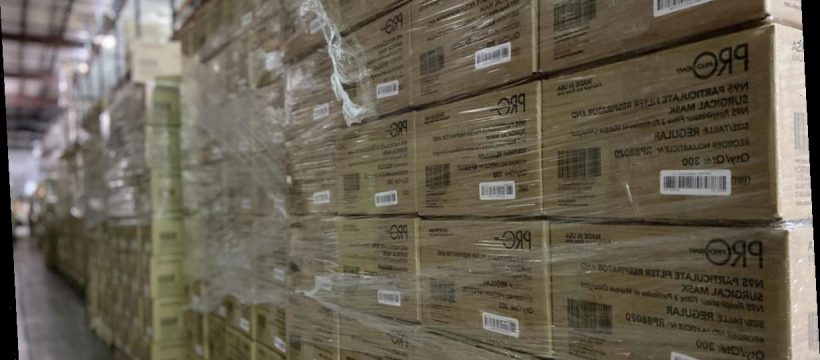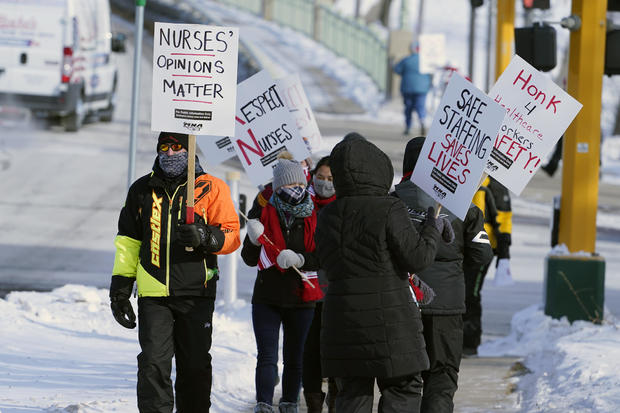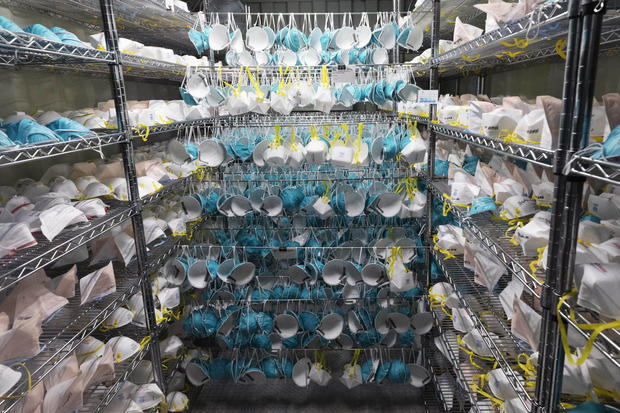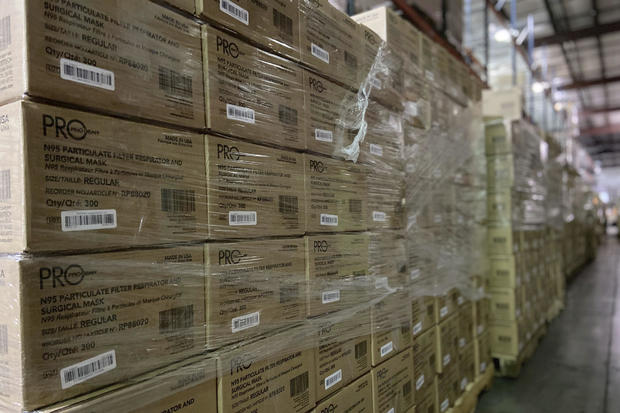One year into the COVID-19 pandemic, millions of medical-grade N95 face masks are pouring out of American factories and heading into storage — yet doctors and nurses say there still aren’t enough to keep them safe.
An Associated Press investigation found a logistical breakdown at the heart of the perceived mask shortage, rooted in federal failures to coordinate supply chains and provide hospitals with clear rules about how to manage their medical equipment.
Exclusive trade data and interviews with manufacturers, federal regulators, hospital procurement officials and frontline medical workers reveal a communication breakdown — not an actual shortage — that is depriving doctors, nurses and others risking exposure to COVID-19 of first-rate protection.
In Fort Worth, Texas, medical-grade mask manufacturer Prestige Ameritech’s warehouse is piled high with cases of N95s. It can churn out 1 million every four days. But there aren’t orders for nearly that many, so Prestige recently got government approval to export them.
“I’m drowning in these respirators,” owner Mike Bowen said.
Meanwhile, Mary Turner, a COVID-19 intensive care nurse at a hospital outside Minneapolis, strapped on the one disposable N95 respirator allotted for her entire shift.
Before the coronavirus pandemic, Turner threw out her mask after each patient to prevent the spread of disease. Now she wears one mask from each infected person to the next because N95s — which filter out 95% of infectious particles — have supposedly been in short supply since last March.
Turner’s employer, North Memorial Health, said in a statement that supplies have stabilized, but the company is still limiting use because “we must remain mindful of that supply” to ensure everyone’s safety.
Internal government emails obtained by The Associated Press show there were deliberate decisions to withhold vital information about new mask manufacturers and availability.
Before the pandemic, medical providers followed guidelines that called for N95s to be discarded after each use. As the masks ran short, the Centers for Disease Control and Prevention modified guidelines to allow for extended use and reuse if supplies are “depleted,” a term left undefined.
Hospitals have responded in a variety of ways, the AP has found. Some are back to pre-COVID-19, one-use-per-patient N95 protocols, but most are doling out one mask a day or fewer to each employee. Many hospital procurement officers say they are following guidelines for depleted supplies, even if their own stockpiles are robust.
Chester “Trey” Moeller, a political appointee who served as the CDC’s deputy chief of staff until President Joe Biden’s inauguration last month, said efforts to increase U.S. mask production succeeded, but the government has failed to connect new suppliers with customers.
“We are forcing our health care industry to reuse sanitized N95s or even worse, wear one N95 all day long,” he said.
Before the pandemic, the U.S. demand for N95s was 1.7 billion per year, with 20% for medical use, trade groups say. In 2021, demand for medical use is estimated by industry sources to be 5.7 billion.
Manufacturers like Bowen stepped in to fill the need.
Still, many hospitals are restricting masks for workers while building their stockpiles over fears of a future COVID-19 surge.
The AP spoke with a dozen procurement officers who buy supplies for more than 300 hospitals, and all said they have enough N95s now, between two and 12 months worth, sitting in storage.
Even so, all but two are limiting workers to one mask per day, or even one per week.
To boost domestic supply, the federal agency that oversees N95 manufacturers, the National Institute for Occupational Safety and Health, has approved 94 new brands, including 19 domestic manufacturers, according to the internal government emails.
But in December, Moeller, an appointee of President Donald Trump, grew frustrated.
“(NIOSH) had approved almost 20 U.S. manufacturers to make N95 masks, but had not published any guidance or notice of what is ultimately more than 100 million N95 mask-making capacity a month going unsold,” Moeller told the AP.
The Food and Drug Administration was monitoring N95 supply chains, and received $80 million in emergency pandemic funds “to prevent, prepare for and respond to coronavirus.” Of that amount, about $38 million was for efforts related to tracking medical product shortages.
But the agency has still not solved the problem.
“There have been a good number of new NIOSH (mask) approvals that have been granted,” said Suzanne Schwartz, director of the FDA’s Office of Strategic Partnerships and Technology Innovation. “Yet the access to those new manufacturers, there seems to be a hurdle there. FDA … is trying to identify that blockage.”
- U.S. Customs has seized millions of counterfeit N95s. Here’s how to spot a fake.
The internal emails show that Moeller in December alerted NIOSH head Dr. John Howard about the unused U.S. N95s.
In a December 22 email, Howard acknowledged he was still hearing of shortages: “Apparently, there is a significant domestic production capacity going unused for the lack of orders and we have tried to address this supplier/purchaser disconnect.”
NIOSH was not actively promoting the new mask producers, Howard wrote, saying that “to avoid the perception of inequitable treatment and because of the dynamic production landscape, we have not posted information on our website regarding respirator availability.”
Howard, through an agency spokesperson, declined a request for an interview. In a statement, NIOSH also acknowledged “a supply and demand disconnect” exists and said it is working to better connect purchasers with U.S.-made masks.
Meanwhile, the U.S. finds itself in a paradox. The more N95s are rationed to alleviate a perceived shortage, the fewer masks are actually reaching the front lines.
Dr. Robert Hancock, an emergency room doctor and president of the Texas College of Emergency Physicians, said hospitals are taking risks by rationing N95s, even when they have enough. He said some doctors tell him they get one N95 mask every five to seven days.
“All the N95s currently out there were designed to be worn once. They were never designed to be reused,” Hancock said.
Source: Read Full Article



